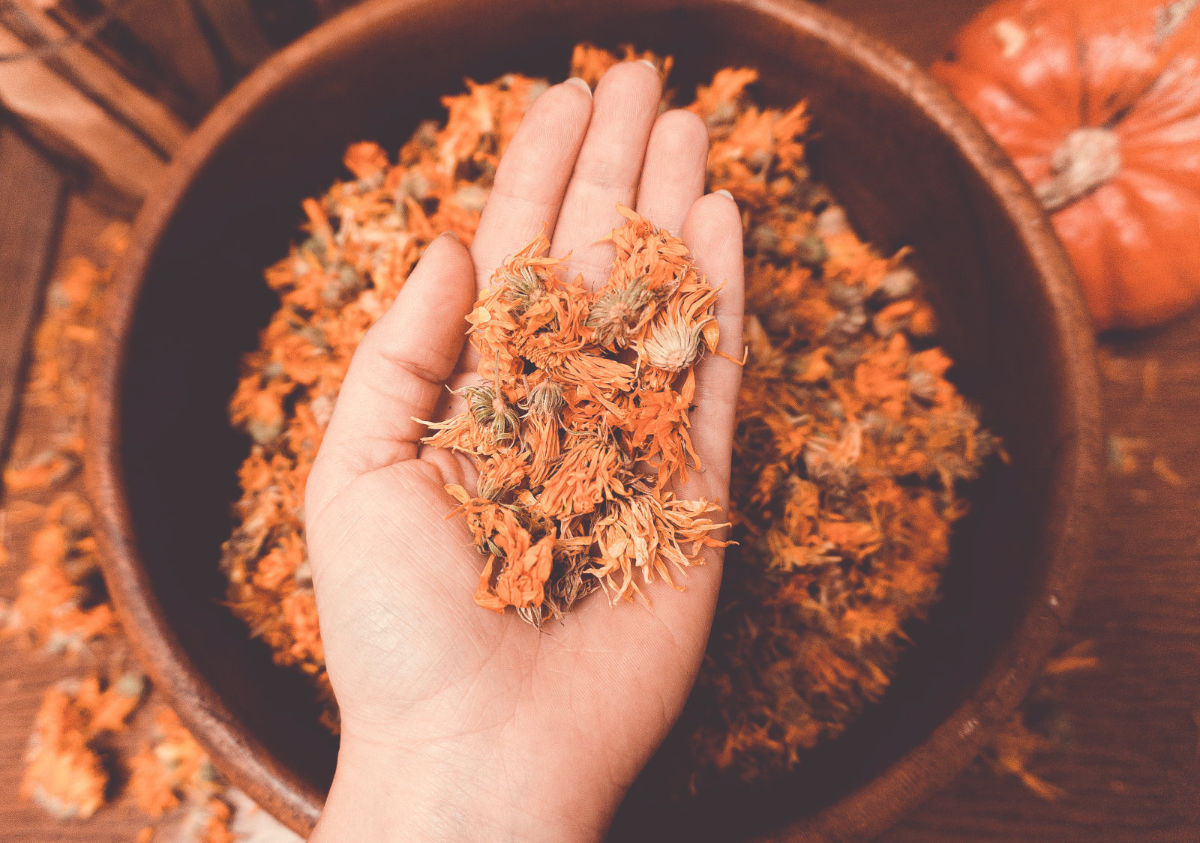Calendula Skincare: A Universal Healing Herb

Calendula is a healing herb that has been used for centuries to heal wounds, soothe burns and fight infection. This post explores the benefits of calendula in skincare products including anti-inflammatory properties, wound healing capabilities, and UV damage protection.
What is calendula?
This plant has many names and over 20 varieties, but all are categorized under the same species name, and one universal function. Calendula Officinalis (pot marigold) was originally used as an ornamental flower in gardens worldwide; however, it soon became apparent that the herb had amazing medicinal properties. It’s now known to be beneficial for skin, supporting digestion, treating wounds, and calming inflammation.
The Latin name “calendula” means “first day of the month”, which refers to its ability to open flowers on even days of every month or week within a season. This unique trait allows farmers to use it as a marker for planting schedules to mature their crops at exactly the right time!

Benefits of using calendula for skincare
The benefits of calendula as a topical treatment have been well-documented. In addition to its use as an antimicrobial agent, it can treat several types of wounds and inflammation. It is also beneficial in treating skin irritations such as dermatitis and psoriasis due to its soothing attributes. Calendula has been used successfully for decades by herbalists around the world to help heal cuts, scrapes, burns, acne scars, eczema or other forms of irritation on the skin from injuries or conditions causing inflammation in pores.
It can be used to make calendula cream or in oil form to add to your daily routine. The organic extracts from this plant also speed up the skin’s healing process.
How to use calendula for skincare
When using calendula on the skin, it is important to know the dosage of consumption because of its strength.
Calendula can be taken orally or applied topically, depending on your health goals. When used orally, carefully follow the dosage instructions listed on your bottle.
For topical use, the standard dosage is one to three times a day and taken either raw or diluted into a carrier oil (such as coconut or jojoba), along with essential oils (lavender or tea tree). It can be added to your bath, or even made into a tincture.
The calendula plant offers many benefits, but it is important to consult with your doctor before taking this herb if you are currently on any medications or have a pre-existing health condition.
The medical uses for calendula include:
- Wound healing
- Soothing itchy, irritated skin (poison ivy, sunburns or diaper rash)
- Reducing the appearance of scarring from cuts, scrapes, or acne lesions
- Contains antioxidants that protect against free radicals, reduces inflammation inside our bodies
For those with sensitive skin, calendula is a great herbal salve to use on its own or in combination with other herbs for eczema treatment. There are no known side effects from using it.

Calendula Uses and Benefits
How to use Calendula cream as sunscreen
Calendula is often included in sunscreen recipes because of its protection from the sun’s UV radiation while promoting healthy skin cell growth.
To use as a sunscreen, find out which oils are best for your specific skin type and add calendula to it, or mix into your favourite body lotion before applying to your face or body.
If you have oily skin, avoid using rosehip oil (it produces more sebum which increases acne problems). Rosehip oil has high levels of omega fatty acids, which is perfect for dry and ageing skin.
Calendula oil for wounds
Calendula contains terpenoids (similar compounds to THC found in cannabis) which can aid in pain relief when applied to an injury or wound.
If this is the first time trying calendula for wounds, be aware that it is thicker and slightly sticky when applied on the kin. The best way to apply the natural oil is by cleaning the cut or scrape thoroughly with natural soap and water, letting it dry, and then applying one drop onto the affected area.
Calendula oil is 100% natural; however, if your doctor has prescribed cream-based treatments instead of natural oils, then they will most likely contain some form of antibiotics that may interact with the calendula oil, and prevent it from working.
Calendula oil for eczema
Calendula oil is used in very small doses to treat dermatitis and eczema. Similarly, it is applied to cuts, scrapes and wounds, but there is one important difference here: dermatitis and eczema can be more serious conditions and should be consulted by your doctor beforehand.
Calendula oil for diaper rash
Calendula is excellent for diaper rashes because it is antibacterial in nature, which can reduce inflammation of the skin caused by diarrhea or skin infection.
In addition to its healing properties, calendula oils are also wonderful moisturizers that will keep your baby’s bottom from dryness. It is an essential part of my natural mama kit and I highly recommend it!
Calendula for anti-ageing
Calendula is an all-purpose skin care ingredient used by those who want to also feel better and look younger.
It helps alleviate common signs of premature ageing such as wrinkles, age spots, and dry skin.
FAQs about using calendula
Can you use Calendula with other herbs or oils?
The answer is yes, you can and special ingredients are not necessary. You can mix it with lavender for example; both are powerful healing oils with some differentiating properties.
The one important reminder is to mix different ingredients that complement each other’s benefits, rather than producing the same benefits.
Where should I store my Calendula tincture/oil?
Keep your tincture or oil in a cool, dark place for the best possible shelf life and to prevent oxidation (deterioration).
Is Calendula safe to use on babies and pregnant women?
Calendula is safe to use on babies and pregnant women; it’s gentle enough and does not cause adverse effects.
How often can I apply this cream/ointment/oil?
You can apply it whenever needed. Unlike most topical remedies, there are no adverse effects for calendula.
Is this a good moisturizer?
This is a highly effective option for those with dry skin! It is a deep moisturizer and hydrator for dry or flaky skin.
Does this help treat acne-prone skin?
Calendula can also help prevent and heal acne by reducing the inflammation of sebaceous glands (i.e. those that secrete an oily substance called sebum).
If used regularly (ie. daily), it keeps pores clean which prevents acne from forming.
Where can I find calendula for skincare?
You can buy it at most health food stores. It is often sold as a herbal remedy for skin conditions, but it may also be found in tea blends or tinctures. The dried flowers are usually available in bulk bins and the oils are typically found on shelves both with and without carrier oils (grapeseed oil, shea butter, etc.)
How do I use calendula?
Typical ways of using herbs include infusions/teas, tinctures, salves/balms/oils and capsules. Infusion: This method uses water to extract its active ingredients.
Is calendula good for all types of skin conditions?
Calendula is helpful for all skin conditions because of its gentle, soothing and healing effects.
Can I ingest calendula?
Yes! You can consume small amounts orally as an occasional supplement (no more than once or twice per week). This works particularly well if you aim to heal infections of the respiratory tract such as bronchitis or tonsillitis; however, consult with a medical professional beforehand.
Calendula is a powerful plant with many uses. Our Lavender Calendula Salve includes lavender essential oil which can help calm your mind while targeting dry or sensitive areas on your face, like lips or around the eyes.
We hope this article helped you in learning about how powerful and amazing calendula really is.






